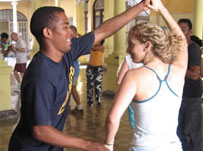Suzanne Furstner Foundation Scholarship 2010: Shortlisted Entry Number 2
Applicants who wanted to apply for the scholarship, which comprises a four-week TEFL course in San Francisco plus a language course, were asked to write a maximum of 1,000 words on the topic ‘San Francisco’, interpreted any way they choose.
The entries were assessed according to the quality of the writing, the relevance to the theme and the accuracy and variety of the language.
You can read Ilaria’s entry in full below.
San Francisco
My students were looking at me as if I was crazy, but hopefully they were unaware of how nervous I was; I said goodbye and we all walked out of the classroom towards the reception desk. They started talking, all together, with the secretary. I couldn’t understand a word of Chinese, but I could see that their expression changed, they seemed really happy and they were frantically looking into their bags for their purses. Were they booking the course? When the secretary confirmed that the students enjoyed the class and 7 out of 10 paid for the Beginners course I was speechless. The demo lesson was torture for me and, I imagined, for them too. It was my first one, I prepared for hours and must have gone over all the suggestions of my trainers about a thousand times before entering the classroom. I wasn’t confident that the topic I chose was suitable and I kept hearing the voices of my colleagues telling me how Chinese students highly considered teachers. No wonder they were surprised to see me sitting in circle with them, and no wonder they were shocked when I asked them how to spell my name on the whiteboard after we practiced the Italian alphabet, at the end of a lesson where not a word of Chinese was spoken.
At the beginning of the first lesson, the week after, they asked me in English if I was going to speak Chinese from then on and were horrified to hear that it wasn’t an option, and not just because it was my second week in China. I felt that they needed to see that we can communicate with people even without speaking their language, so I invited them to come with me and see how I ordered my dinner at the restaurant downstairs. The owner was used to my “pointing” and the silent conversation went on as usual with me indicating a picture on the wall, him writing down the price, me paying and happily walking out of the restaurant with my dinner. We went back to the classroom, I gave them an Italian menu full of pictures, I took their silent order and wrote down the price; they realized that we were all in the same boat. No matter how hard it was, we had a lot of fun and we all learnt so much from one another. At the end of a long day, when I was reviewing their written tasks, I felt proud of their progress and proud of myself, not because I am a good teacher, but because I achieved my goal.
After pursuing a career in translation, having worked for free as an intern for an independent Italian publisher and having published several translations, I went travelling in Spain and accepted a volunteer position as teacher of Spanish for the local Town Hall. It soon became clear that being with my students was far more rewarding than those endless, lonely hours in front of the computer, just like seeing my name on a language certificate rather than on the inner cover of a book.
How do you give up years of effort and say goodbye to lucrative contracts without feeling guilty towards those who supported you for all the time it took to get there? At 34, all I was hearing from friends were engagement plans and house mortgages, while I was talking about re-inventing myself, go back to school and become a teacher. And after my training course, when those friends who got married were talking about having children, I was over the moon because I got my first official job as a teacher, in China!
After this first experience, I want to learn more about teaching and I would like to create the basis for my future. I know I will never be a sought-after English teacher as I am not a native speaker, but that might not be the case everywhere, if I can be a good teacher. San Francisco is the link between my most recent past in China and my future anywhere I’ll be needed, as it is the door to a better world for so many people, not just from Asia. San Francisco raised again from its own ashes and it was chosen as the ideal place by millions of people who felt it was time to live their lives instead of what everybody else defined as such; great writers were inspired by its vibrant atmosphere and the grandeur of its landscapes and those same writers inspired me when it was time to start all over again.
I became a bit of every place I have been to and I learnt the language of every country I lived in; if by doing my job I can inspire even only one of my students to go and experience a different culture, I’ll be happy. He or she might have to travel for miles, or just be willing to listen to a neighbour from a different country. In some places people are never more abroad than when they are at home. But I didn’t say that, Benjamin F. Taylor did, about San Francisco.


 French in the morning and chilling out on palm-fringed beaches in the afternoon. Add to this a good dose of Caribbean and Creole culture, and winter back home will soon be a distant memory.
French in the morning and chilling out on palm-fringed beaches in the afternoon. Add to this a good dose of Caribbean and Creole culture, and winter back home will soon be a distant memory.







